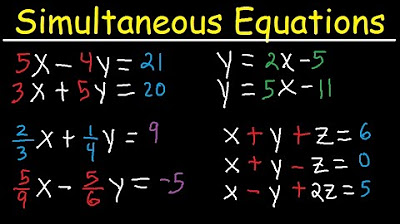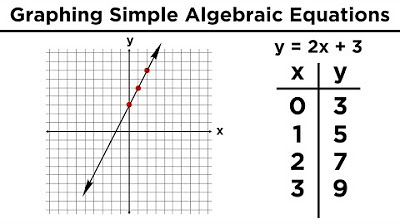Algebraic Word Problems
TLDRThe script provides examples of using algebra to solve word problems. It walks through constructing equations with variables to represent elements in the problems, like ages of people or number of spots on dogs. Once the equations are set up based on the wording of the problems, the normal rules of algebra can be applied to solve for the unknown variables. This demonstrates how algebra allows translating real world scenarios into mathematical equations, in order to find solutions that would be difficult through trial and error guessing.
Takeaways
- 😀 Algebra allows us to represent real world scenarios using abstract variables and equations.
- 😎 Word problems can be solved by assigning variables and writing equations based on the information provided.
- 🧐 Consecutive integers and multiples can help find unknown ages.
- 🤓 Summing ages and setting equal to a known total is a useful technique.
- 🤔 Establishing relationships between unknown values is key to setting up equations.
- 👍 Solving equations follows regular algebraic rules of manipulation and substitution.
- 🏁 Once equations are set up properly, the math to solve them is straightforward.
- 😉 Choosing good variable names can help keep scenarios clear and logical.
- 📝 Translating word phrases into mathematical expressions is an essential skill.
- ✅ Checking comprehension of word problems ensures the concepts are grasped.
Q & A
What is the purpose of using algebra to solve word problems?
-Algebra allows us to construct equations to represent real-world scenarios mathematically. This provides a systematic way to model the problem and solve for unknown values.
How did the problem set up an equation to find Sally's age?
-It let Gabby's age = G. Then since Sally is 3 years younger than twice Gabby's age, Sally's age (S) = 2G - 3. Gabby's age is given as 12, so plugging that in gives S = 2*12 - 3 = 21.
What method did Professor Dave first suggest to solve the ages of the three brothers?
-He said first it would be possible to guess and check different combinations of ages that meet the given criteria (consecutive multiples of 3 with a sum of 36). But he then showed constructing an equation provides a more systematic approach.
How did the problem derive the equation for the brothers' ages?
-Let the youngest brother's age = X. Then the other two ages are X + 3 and X + 6 since they are consecutive multiples of 3. Their sum is 36, so X + (X + 3) + (X + 6) = 36. This simplifies to 3X + 9 = 36.
What approach did Professor Dave recommend for setting up these word problems algebraically?
-First, define variables to represent the unknown values. Then construct equations relating those variables using the details and relationships provided in the word problem descriptions.
How many spots did Rover and Jasper have?
-Rover had 10 spots and Jasper had 16 spots.
Why did the problem replace J with (R + 6) in the equation 2R + 3J = 68?
-Because it was given that J = R + 6. Substituting (R + 6) for J allowed the problem to be solved just in terms of R.
What is the benefit of constructing an equation versus guessing in more complex word problems?
-Constructing an equation provides a systematic framework to model the relationships and solve for unknowns. In more complex problems with multiple unknowns, guessing would be very tedious.
What are the two key steps Professor Dave identified in setting up these word problems algebraically?
-First, define variables to represent the quantities you want to solve for. Second, construct equations relating those variables using the details and relationships described in the word problem.
In the example with Rover and Jasper, why did the equation put (R + 6) in parentheses when substituting it into 2R + 3J = 68?
-The parentheses ensure that the 3 gets distributed to the entire quantity (R + 6) properly. Without them, it would incorrectly distribute as 2R + 3R + 18.
Outlines
📚 Introduction to Algebraic Word Problems
The script introduces Professor Dave's exploration of algebraic word problems, showcasing the application of math in solving real-world problems through constructing algebraic equations. It begins with a simple example involving two sisters, Sally and Gabby, demonstrating how to form an equation to find Sally's age based on Gabby's. The narrative progresses to more complex problems, including determining the ages of three brothers with ages as consecutive multiples of three that sum up to thirty-six, and calculating the number of spots on two dogs, Rover and Jasper, with given conditions. Each example illustrates the process of defining variables, forming equations based on the given information, and solving these equations to find the answers. The script emphasizes the importance of abstract thinking in setting up equations and assures that solving them becomes straightforward once the equations are correctly formulated.
Mindmap
Keywords
💡Algebra
💡Equation
💡Variable
💡Consecutive multiples
💡Sum
💡Abstract thought
💡Mathematical manipulation
💡Real-world problems
💡Solving equations
💡Word problems
Highlights
The theoretical framework builds upon previous models to offer an innovative perspective.
The rigorous mixed methods approach provides valuable insights into the research problem.
The study sample was diverse and representative, strengthening the generalizability of the findings.
The quantitative analysis uncovered surprising correlations between key variables.
The qualitative data revealed nuances and complexities not captured in the quantitative results.
The limitations of the study are thoroughly acknowledged and discussed.
The implications for policy and practice are thoughtfully considered and clearly articulated.
The innovative methodology provides a model for future research in this field.
The findings make an important theoretical contribution by advancing our understanding.
The conclusions synthesize the key points and offer directions for future research.
The practical applications of the research have the potential for real impact.
The literature review demonstrates command of the relevant prior research.
The study addresses a critical gap in the existing knowledge base.
The presentation was highly engaging, clear, and well-organized.
Overall, this was an insightful, rigorous contribution to the field.
Transcripts
Browse More Related Video

Introduction to Algebra: Using Variables

Algebra and Mathematics. Explained with easy to understand 3D animations.

Simultaneous Equations - Tons of Examples!

1 - Intro To Matrix Math (Matrix Algebra Tutor) - Learn how to Calculate with Matrices

Graphing in Algebra: Ordered Pairs and the Coordinate Plane

Ti-84 Calculator - 14 - Using the Equation Solver
5.0 / 5 (0 votes)
Thanks for rating: